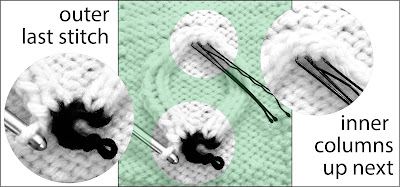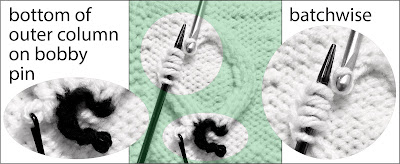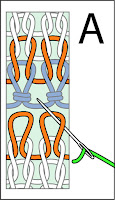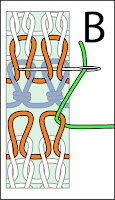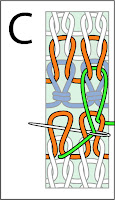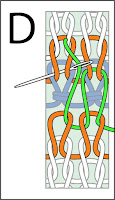This is an extract from the TECHknitting post about DOUBLE BOWEN CELTIC KNOTS. It shows how to transform a bottom cable arm running under a top cable arm, when transforming a Celtic Knot via INFINITY LOOPS, working the LONG WAY (no shortcuts). For further details, go to the original post.
Transforming an "under"
If you choose to work a transformation the long way (no shortcuts) there will come a time when you have to transform around the cross on a cable arm.
These crosses come in two flavors: "overs" and "unders." Transforming "overs" is simply no different than regular transformation. The stitches doing the cross-over are no different than any other stitches in the column, and are transformed the same way, it being immaterial whether another cable arm is passing under those particular stitches.
This is not true of "unders," which are a bit more complicated. Here is how to transform an "under" in 5 illustrated steps.
1. Transform the outer column in the usual way, all the way down to the cable cross. The bottom loop of the outer column being transformed is colored blue, the stitch below it, red. The red stitch is the one which actually crosses behind the cable. I put it on a coiless safety pin and pulled it forward, just so you could see it peeking out from under the upper cable arm. In the ordinary course of things, the red stitch would NOT be visible. It would simply be waiting on the back of the fabric; not pulled forward, not put on a safety pin.
2. Not illustrated. The head of the blue stitch is pulled to the back using the hook. Then, the fabric is flipped. Next, the red stitch is strandified, then re-formed into a stitch by being pulled through the blue loop. (Of course, in this particular case, the red stitch was taken off its safety pin to strandify it, but usually, the red stitch would just be sitting there waiting on the back, with no safety pin through it)
3. This is a view of the fabric back after step 2. Due to the red stitch having been strandified and re-formed into a stitch, the red strand has been pulled through the blue and is now the lead stitch in its column. The red stitch is now to be put on a coil-less safety pin or a bobby pin as a holder in real life. In other words, in this step, the pin isn't just for demonstration purposes unlike in step 1. In this step, you actually DO want to put the red stitch on a safety pin or other holder. As you'll see in the step 5, having the red stitch on a holder will help maneuver the stitch from the back to the front as part of the "undercrossing" being transformed. The green hole shown at picture 4 is not visible in this view, because the red stitch is flopped over it.
4. This is a view of the fabric front. The stitch which was below the red stitch is colored purple. It is the first stitch past the cable crossing in the same column, the first stitch of its loop which sees daylight. It was waiting on the fabric front, and has now been put on a bobby pin for safekeeping. In this photo, I have stretched the fabric so you can now see the hole (green arrow). This hole is above the purple stitch, and was hidden by the red stitch in illustration 3. Therefore, above the hole, at the back of the fabric where you cannot see it in this picture, the red stitch waits on its holder, as shown in picture 3.
5. Using the pin as a handle, the red stitch has been pulled through the hole marked with the green arrow. This fills the hole so it no longer exists.
Here you see a comparison of the cable cross before and after transformation of both the outer and inner columns. The gray V's show that transformation reverses the stitch direction (which is what eliminates the green- and red-dot discontinuities). The blue and purple stitches remain in the same position, just turned on their heads. The red stitches (which have also been stood on their heads) are not visible: they are on the fabric back. The green hole no longer exists, having been plugged when the red stitches (invisible on the fabric back) re-connected with the purple during transformation.
Transforming an "under" resembles correcting a miscrossed cable by letting out a ladder and latching it up again, but without turning the "under" into an over, and with the added feature of strandifying and turning the stitches upside-down as they are transformed.










